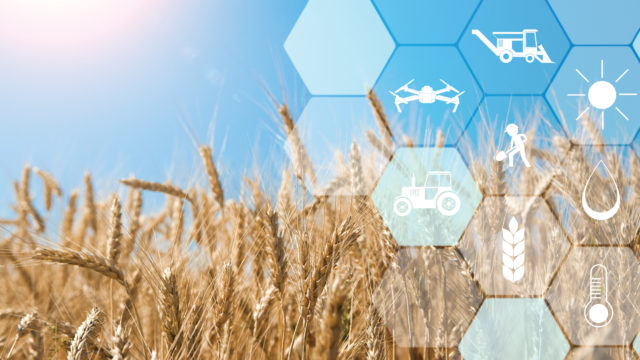
by John Hardy
The practical and real demands as well as challenges of today’s farmers usually don’t leave much time or opportunity to find out what’s new or possible related to the vital efficiencies of producing food.
Innovation, technology and a tsunami of changes are transforming the farm and creating a new normal.
The ag industry is navigating countless new ways of doing things and dealing with speedbumps. Some exciting, some challenging. From new techniques, the rising cost of supplies, the rollercoaster of the economy, the gradual recovery from the coronavirus outbreak, and most significantly, the impact of technology.
Precision agriculture companies are now developing new technologies that allow farmers to maximize yields by controlling every variable of crop farming such as moisture levels, pest stress, soil conditions, and micro-climates. Smart farming makes operations more efficient in various ways, like automating the crop or livestock production cycles, seeding and weeding with autonomous tractors, the crucial ability of remote sensing, robotic harvesters and automatic watering possibilities.
There’s no doubt about it. Constant updating and advancements in ag technology—from state-of-the-art digital options to computer vision software—are altering modern farming. It’s an undisputed fact that technology has become an indispensable part of most commercial farms.
That’s one of the several key reasons why AgSmart 2020 will be timely, relevant and important. AgSmart is a dynamic and valuable two days of information, question-and-answer, seminars, demonstrations and exhibits all set for at Olds College on Aug. 11-12, 2020.
“We developed AgSmart to create a cutting-edge learning and demonstration event for producers and Canada’s ag sector as a whole,” says Patrick Machacek, vice-president, development and strategy at Olds College. “AgSmart profiles the latest technologies aimed at improving productivity and it is developed to bridge the gaps for producers who are incorporating ag tech into their operations and would like to learn how to do it more effectively and efficiently.”
According to Fred Wall, the vice-president of marketing with FCC: “The two day event at Olds College will help producers discover the many ways that technology and data management can maximize the potential of their operations.
“The most critical aspects about today’s agriculture are also the most underrated,” he says.
“Digitizing farm records makes everything else possible. The simple act of digitizing the farm’s field and financial records can have a lasting, positive impact on the operation of the farm. We see better financial outcomes. Greater productivity in connecting different tools and improved efficiency in doing the work that needs to get done anyway, like crop insurance reporting.”
New advancements in technologies ranging from robotics to financial record software and drones are continually evolving and re-defining contemporary agriculture. And while ag technology is constantly updating and evolving, not all vital farm technology is new. Some, such as GPS, have been popular and important agricultural tools since the late 1990s.
“Drones specifically for agriculture are the culmination of advancements in aeronautics, robotics, geomatics and remote sensing,” says Markus Weber, president and co-founder of LandView Drones.
He points out that drones provide two key benefits for farmers: time savings and identification of problems. “Producers can access distant parts of their field or pasture in mere minutes, even if the landscape or crop is otherwise nearly impossible to get through, like canola in August. Another advantage of drones on the farm is making it a lot easier to spot crop problems—with equipment, fertility, water or soil—with just a little bit of altitude.”
Weber admits that, on the learning curve of ag technology, interest in drones is just beginning. “Drones haven’t yet revolutionized farming, but they are being adopted quickly by farmers young and old alike. Much like smartphones, drones have hundreds of applications on the farm.”
Contrary to popular myth, age is not such a big factor when it comes to Canadian farmers embracing ag technology, being dubbed “overrated” by Wall. “What matters most to the farmers is the quality of the tools and how they work together,” he says. “We hear about three obstacles to adoption: trust, complexity, and ROI. Farmers won’t use a tool if they don’t trust the provider or if they don’t trust the generated data. How complex and difficult to use is the tool? And ROI is obvious: does the tool offer a positive return, in cost of acquisition or cost of learning?”
The show focuses on the latest available data and technology in agriculture today.
“How to gather it, how to use it, how it benefits the producer and identify reasons why it makes sense to invest in equipment and technology to capture data and implement the data to increase productivity and profitability for farm operations,” says Machacek.
“And during the two days of AgSmart, farmers will have opportunities to interact with cutting-edge high-tech ag players and experience the latest innovations first-hand. It will also be a valuable source for the latest information, featuring education workshops, in-field demonstrations and an exhibit fair profiling some of the latest commercialized products that are transforming the ag industry in Alberta and the world. And for ag tech companies, it is an opportunity to provide information and demonstrate their technology and data-driven products and services.”
Wall underscores the limitless potential and positivity of technology on the farm.
“We value Ag tech and encourage producers to attend AgSmart and see for themselves what the future of agriculture in Canada looks like,” he says. “Farmers always adapt when it makes sense to do so.”
Getting ready for AgSmart, Machacek is gung-ho. “It is exciting times in the Ag industry, with innovation and ingenuity taking us to new frontiers,” he says.








